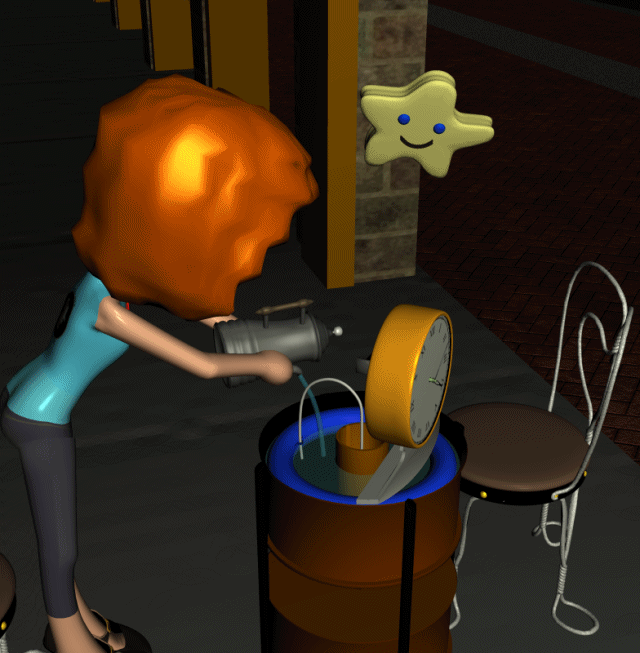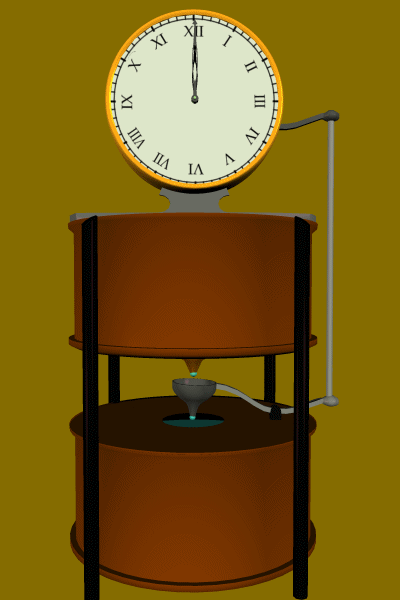Tuesday, July 14, 2020
Yet another weird French clock
This is remarkably similar to the Gabry lamp-clock in its appearance and history. Invented and described in French scientific texts, but probably not built.
It's not especially pretty, but it is 'patient' in a unique way, using equipoise and differential action.
Behold Tiffereau's ticking water-clock, the last of the clepsydras!
 Why is it remarkable? It uses differential action in two separate ways.
First, it guarantees that a steady flow reaches the 'drip point', using a siphon tied to a float.
Why is it remarkable? It uses differential action in two separate ways.
First, it guarantees that a steady flow reaches the 'drip point', using a siphon tied to a float.
 As the water in the source tank rises and falls, a float carries a siphon. The inlet of the siphon is always below current water level, and the outlet is always inside the nearly-empty inner drip chamber. Thus the hydraulic pressure in the drip chamber remains relatively constant as you fill and empty the main source tank. (This action resembles the Willson automatic buoy.)
= = = = =
The second use of balance and equipoise is more interesting. Each drip from the inner drip chamber hits a delicately balanced spoon. When the drip hits the spoon, its weight pushes the spoon down for a moment ... until the drip exits the spoon into the lower tank. At that moment the spoon rises again. Each fall of the spoon ticks the clock forward.
As the water in the source tank rises and falls, a float carries a siphon. The inlet of the siphon is always below current water level, and the outlet is always inside the nearly-empty inner drip chamber. Thus the hydraulic pressure in the drip chamber remains relatively constant as you fill and empty the main source tank. (This action resembles the Willson automatic buoy.)
= = = = =
The second use of balance and equipoise is more interesting. Each drip from the inner drip chamber hits a delicately balanced spoon. When the drip hits the spoon, its weight pushes the spoon down for a moment ... until the drip exits the spoon into the lower tank. At that moment the spoon rises again. Each fall of the spoon ticks the clock forward.
 I'm showing the ticks as minutes here for convenience, but they would probably be closer to seconds in the real thing, if it was ever built.
I'm showing the ticks as minutes here for convenience, but they would probably be closer to seconds in the real thing, if it was ever built.
 Why is it remarkable? It uses differential action in two separate ways.
First, it guarantees that a steady flow reaches the 'drip point', using a siphon tied to a float.
Why is it remarkable? It uses differential action in two separate ways.
First, it guarantees that a steady flow reaches the 'drip point', using a siphon tied to a float.
 As the water in the source tank rises and falls, a float carries a siphon. The inlet of the siphon is always below current water level, and the outlet is always inside the nearly-empty inner drip chamber. Thus the hydraulic pressure in the drip chamber remains relatively constant as you fill and empty the main source tank. (This action resembles the Willson automatic buoy.)
= = = = =
The second use of balance and equipoise is more interesting. Each drip from the inner drip chamber hits a delicately balanced spoon. When the drip hits the spoon, its weight pushes the spoon down for a moment ... until the drip exits the spoon into the lower tank. At that moment the spoon rises again. Each fall of the spoon ticks the clock forward.
As the water in the source tank rises and falls, a float carries a siphon. The inlet of the siphon is always below current water level, and the outlet is always inside the nearly-empty inner drip chamber. Thus the hydraulic pressure in the drip chamber remains relatively constant as you fill and empty the main source tank. (This action resembles the Willson automatic buoy.)
= = = = =
The second use of balance and equipoise is more interesting. Each drip from the inner drip chamber hits a delicately balanced spoon. When the drip hits the spoon, its weight pushes the spoon down for a moment ... until the drip exits the spoon into the lower tank. At that moment the spoon rises again. Each fall of the spoon ticks the clock forward.
 I'm showing the ticks as minutes here for convenience, but they would probably be closer to seconds in the real thing, if it was ever built.
I'm showing the ticks as minutes here for convenience, but they would probably be closer to seconds in the real thing, if it was ever built.Labels: Equipoise, Morsenet of Things, Patient things
